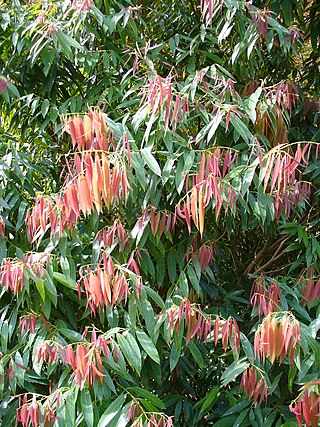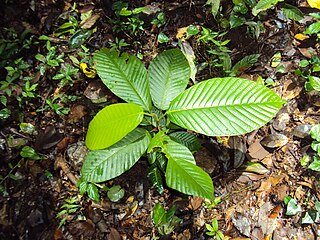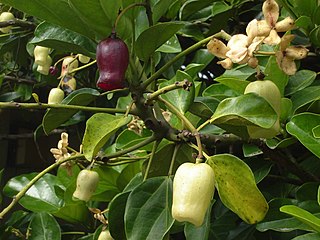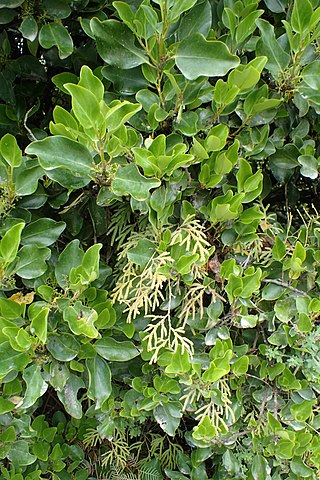
Rafflesia is a genus of parasitic flowering plants in the family Rafflesiaceae. The species have enormous flowers, the buds rising from the ground or directly from the lower stems of their host plants; one species has the largest flower in the world. Plants of the World Online lists up to 41 species from this genus, all of them are found throughout Southeast Asia.

Schizostachyum is a tall or shrub-like tropical genus of bamboo. They are natives mostly of tropical Asia and Papuasia, with a few species in Madagascar and on certain islands in the Pacific. A few have become naturalized in other tropical regions.

Mesua is a genus of flowering plants in the family Calophyllaceae, native to tropical southern Asia. Common names include ironwood and rose chestnut.

Dipterocarpus is a genus of flowering plants and the type genus of family Dipterocarpaceae.

Hanguana is a genus of flowering plants with a dozen known species. It is the only genus in the family Hanguanaceae.

Daphniphyllum is the sole genus in the flowering plant family Daphniphyllaceae and was described as a genus in 1826. The genus includes evergreen shrubs and trees mainly native to east and southeast Asia, but also found in the Indian Subcontinent and New Guinea.

Koompassia is a genus of legume in the family Fabaceae. It includes three species with range across southeast Asia, from Thailand to New Guinea. It belongs to the subfamily Dialioideae. They are tall tropical rainforest trees; K. excelsa is one of the tallest tree species in the tropics.
Leucostegane is a genus of plants in the family Fabaceae. It includes two species of trees native to western Malesia – Borneo, Sumatra, and Peninsular Malaysia.

Acriopsis, commonly known as chandelier orchids or 合萼兰属 is a genus of flowering plants in the family Orchidaceaes. Orchids in this genus are epiphytic herbs with spherical or cylindrical pseudobulbs, creeping, branched rhizomes, thin white roots, two or three leaves and many small flowers. The flowers are non-resupinate with the lateral sepals joined along their edges and have spreading petals and a three-lobed labellum. The column has projections that extend hood-like beyond the anther.

Atuna is a genus of plants in the family Chrysobalanaceae described as a genus in 1838. It is native to the Indian Subcontinent, Southeast Asia, and various islands of the western Pacific.

Schoutenia is a genus of flowering plants. It ranges from Indochina through Malaysia, Indonesia, New Guinea, and Northern Australia.

Anisoptera is a genus of plants in the family Dipterocarpaceae. It contains ten species distributed from Chittagong in southeast of Bangladesh to New Guinea.

Callerya is a genus of flowering plants in the legume family, Fabaceae. It belongs to the subfamily Faboideae, tribe Wisterieae. It includes 12 species native to the eastern Himalayas, Indochina, southern China and Taiwan, and Peninsular Malaysia. Its species are climbers, generally reaching up to about 1 m (3 ft) tall. The genus has a somewhat complicated taxonomic history; its circumscription was substantially revised in 2019.
Dysolobium is a genus of flowering plants in the legume family, Fabaceae. It belongs to the subfamily Faboideae. It includes five species native to tropical Asia, ranging from the Himalayas through Indochina to southern China, Taiwan, the Philippines, Peninsular Malaysia, and Java.

The tribe Millettieae is one of the subdivisions of the plant family Fabaceae.
Diospyros venosa is a tree in the family Ebenaceae. It is native to Southeast Asia, from the Maluku Islands to Myanmar. It provides raw material for handicrafts, traditional medicine and fuel.
Vesta is a genus of flowering plants in the family Araceae, formally described in 2018. It contains only one known species, Vesta longifolia, native to Perak in Peninsular Malaysia and to Brunei and Sarawak on the island of Borneo.
Dischidanthus is a genus of plants in the family Apocynaceae, first described as a genus in 1936. Species of the genus are native from the east Himalayas to south China and Peninsular Malaysia. It may be treated by some sources as a synonym of Marsdenia.
Pentasacme, sometimes spelled Pentasachme, is a genus of flowering plants in the dogbane family (Apocynaceae). It contains six species which range from the Himalayas through Indochina to southern China and Peninsular Malaysia. The genus was first described in 1834.

Pseudodiphasium is a genus of lycophyte in the family Lycopodiaceae with only one species, Pseudodiphasium volubile. In the Pteridophyte Phylogeny Group classification of 2016, the genus is placed in the subfamily Lycopodioideae. Some sources do not recognize the genus, sinking it into Lycopodium. Pseudodiphasium volubile is native from Peninsular Malaysia to Queensland, Australia, and has been introduced into Ecuador.













